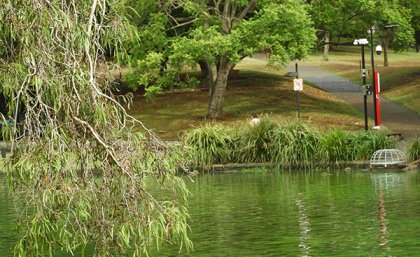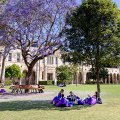
Brisbane’s run of dry weather has led to algal blooms that have turned the water of The University of Queensland’s St Lucia lakes a luminous shade of green.
UQ Energy and Sustainability Manager Andrew Wilson said such outbreaks were common in freshwater lakes in South East Queensland.
He said steps had been taken to mitigate any risk to wildlife and people.
“We have reduced the output of the fountain to reduce the risk of aerosol spray and stopped irrigation from the main lake,” he said.
“Warning signs have been erected and water samples are being taken fortnightly.
“I suspect many lakes in the region are in a similar condition – it’s just that our beautiful lakes are highly visible.”
Algal blooms can change the smell and appearance of shallow water bodies in the summer months when still, warm water is exposed to sunlight.
The bright green colour is due to chlorophyll (green) and phycocyanin (blue) pigments in the algae cells.
Mr Wilson said such blooms were a normal part of the seasonal cycle and UQ staff monitored lake water quality throughout the year.
 “It’s important to understand that not all blooms are toxic, and we have taken as many precautionary actions as we can.
“It’s important to understand that not all blooms are toxic, and we have taken as many precautionary actions as we can.
“The lakes should return to pre-bloom conditions when temperatures decrease.”
“In the meantime we are regularly monitoring.
"The most recent results do not exceed the National Health and Medical Research Council guideline values for recreation (contact) and toxic species numbers were low."
He said students, staff and visitors should avoid contact with the water in the lakes.
“Several species of blue-green algae can potentially produce toxic conditions which could present health issues through direct contact,” he said.
Queensland Health advises people who come into contact with algal bloom water to use clean tap water to thoroughly rinse the skin and sensitive areas of the face such as the eyes, mouth and nose.
Media: UQ Communications, communications@uq.edu.au, +61 7 3365 1120.

.jpg?itok=A3VEKM1Y)










